
Curved Microtunnel Drive Helps Improve Water Quality in Seattle’s Ship Canal
In July 2023 Northwest Boring (NWB) completed a curved microtunnel beneath the Washington Ship Canal in Seattle, Washington as part of the Ship Canal Water Quality Project (SCWQP).
The SCWQP is designed to provide offline storage for the combined sewer overflow (CSO) flows from five Seattle Public Utilities (SPU) and two King County Department of Natural Resources and Parks (DNRP) CSO basins to meet parts of the City of Seattle’s and King County’s Consent Decrees.
For the microtunnel alignment, baselined ground conditions included glacially over consolidated, dense to very dense silt, fine sandy silt, silty fine sand and gravel (till) with scattered cobbles and boulders.
Microtunnel work involved jacking a 96-in. inside diameter, 118-in. outside diameter RCP, equipped with Jackcontrol hydraulic joints, along an alignment that included: a 67-ft long straight section, a 367-ft long curved section excavated along a 650-ft radius curve, followed by a 182-ft long straight section.
NWB selected a Herrenknecht, AVN 2000AB MTBM to excavate the alignment with the RCP casing pipe, aforementioned hydraulic joint system and intermediate jacking station (IJS) designed by Swiss firm Jackcontrol in accordance with the project specifications. The MTBM was christened Helene after NWB vice president, Dennis Molvik’s Norwegian immigrant mother. (Featured image) .

Figure 2 – The Fremont Shaft (FRS) jacking frame, concrete pipe,
pipe brake and seal ring.
Figure 2 is a photograph of the 90-ft deep FRS jacking shaft showing the curved microtunnel system components, thrust block, entry seal, pipe brake and jacking frame. The embedment ring was recessed in the final shaft lining to facilitate installation of a microtunnel plug that was dowelled into the end of the casing pipe during the carrier pipe installation process.
Early Progress
NWB launched the MTBM in August 2021 and progress was uneventful until Sept. 2, 2021 when large inflows of water and lubrication were experienced in the joint between Pipe No. 8 and Pipe No. 7 as Pipe No. 9 was being jacked into place. Microtunneling operations were stopped, and worker safety was assessed.
NWB immediately recognized that inflows could flood the shaft and using hydraulic pressure against the MTBM cutter face moved the failed joint along with the entire MTBM and other pipe joints backward about 15 in. to a position inside the inflatable seal.

Figure 3 – A look inside the 96-in. ID RCP microtunnel.
NWB immediately engaged with the owner and started a program of root cause analysis, risk assessment, forensic investigation, as well as parallel insurance notifications and a myriad of other interactions all in concert with NWB’s Casualty Management Plan.
This plan had previously been developed for such an occasion and paved the way through a complicated process of problem resolution and the inevitable problems and conflicts that develop when a microtunnel project encounters a catastrophic failure.
Preparations for Completing the Microtunnel
A plan to remove and replace the failed Pipe No. 8 was developed after development of a recovery plan and risk analysis that was shared with all interested parties and approved by the owner.
It was decided that the pipe string would again be pushed backward using the same process initially used to move the joint between Pipe Nos. 8 and 7 safely within the inflatable seal. This was successfully performed and the failed Pipe #8 was removed.
At this stage, it was determined that the remaining uninstalled pipe would need to be inspected and subsequently repaired if needed. NWB subsequently evaluated, using risk analysis, whether the first eight RCP pipes that had already been microtunneled would need to be removed or if it would be less risky to proceed leaving them in place.
The risk analysis determined that the already installed RCP should be left in place but recommended risk mitigation using Miller Pipeline’s WEKO-SEAL across the joints and the utilization of joint restraints if needed to constrain joint movement should a gasket failure occur.
Curved Microtunnel Project Completion
Required equipment was designed and procured or constructed, RCP repair procedures were developed and reviewed and RCP repairs were completed, all of which occurred over an approximate 12-month period.
On Oct. 25, 2022 NWB performed a test of the MTBM system, ensuring that the entire pipe string that had sat in place for approximately 14 months could still progress forward. After this test, microtunneling then recommenced. See Figure 3 for a picture of the inside of the 96-in. ID RCP microtunnel.

Figure 4: Joint restraints installed across the first five RCP pipe joints.
With only 15 more pipe segments to go until break in to the receiving shaft, NWB encountered another problem in that at two of the joints, the joints between Pipe Nos. 2 and 3 and the joint between Pipe Nos. 4 and 5, the WEKO-SEALs that were covering those joints were bulging. This meant that up to 2 bar of groundwater pressure was now acting on the inside face of the bell and the spigot of these pipe joints thereby complicating the recovery of the MTBM.
This necessitated the installation of joint restraints across those joints in order to tie the first five pipes together and keep them from pushing apart when the MTBM was removed. (Figure 4)
On Jan. 26, 2023, the MTBM broke into the 3RS receiving shaft and on Feb. 8, 2023, the MTBM (Helene) was lifted out of the receiving shaft and set on a trailer, for her next journey.
Dr. Chris D. Breeds, P.E., is microtunnel engineer at SubTerra Inc. Dennis Molvik is vice president and Don Gonzales is president at Northwest Boring Co.




